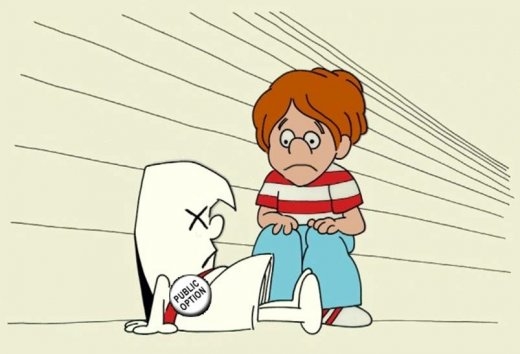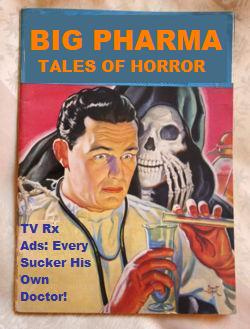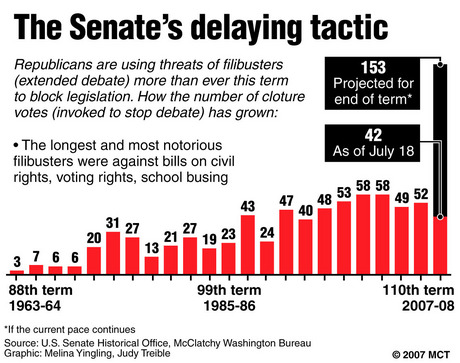
RUSS FEINGOLD: I’ve been fighting all year for a strong public option to compete with the insurance industry and bring health care spending down. I continued that fight during recent negotiations, and I refused to sign onto a deal to drop the public option from the Senate bill. Unfortunately, the lack of support from the administration made keeping the public option in the bill an uphill struggle. Removing the public option from the Senate bill is the wrong move, and eliminates $25 billion in savings. I will be urging members of the House and Senate who draft the final bill to make sure this essential provision is included. MORE
CHICAGO TRIBUNE: Our new president who arrived promising that he’d do everything to pass health-care reform did very little in the face of a big-money onslaught by an army of lobbyists for the big pharmaceutical corporations, the health insurance industry and other parts of the for-profit health-care industry. He began by getting rolled by Big Pharma at a much-ballyhooed White House conference with pharmaceutical executives. He traded away a key piece — the idea that the federal government would negotiate lower prices for the drugs we need — in exchange for empty promises of a “donation” of $80 billion in voluntary price reductions on those drugs. His biggest mistake of all, however, was leaving it to Congress to negotiate the whole reform package in closed-door meetings of six senators here, 10 senators there, in committees controlled by senators whose votes already had been bought and paid for by the health-care corporations. Where was the bold and courageous leadership so necessary for this badly needed initiative? Instead of declaring at the outset that he wouldn’t sign a bill that didn’t contain the single-payer option — the only honest player in a crooked poker game, the only real competition that could curb the greed that now sucks 20 cents profit and overhead out of every dollar of health insurance premiums — Obama signaled that everything was negotiable. MORE
a big-money onslaught by an army of lobbyists for the big pharmaceutical corporations, the health insurance industry and other parts of the for-profit health-care industry. He began by getting rolled by Big Pharma at a much-ballyhooed White House conference with pharmaceutical executives. He traded away a key piece — the idea that the federal government would negotiate lower prices for the drugs we need — in exchange for empty promises of a “donation” of $80 billion in voluntary price reductions on those drugs. His biggest mistake of all, however, was leaving it to Congress to negotiate the whole reform package in closed-door meetings of six senators here, 10 senators there, in committees controlled by senators whose votes already had been bought and paid for by the health-care corporations. Where was the bold and courageous leadership so necessary for this badly needed initiative? Instead of declaring at the outset that he wouldn’t sign a bill that didn’t contain the single-payer option — the only honest player in a crooked poker game, the only real competition that could curb the greed that now sucks 20 cents profit and overhead out of every dollar of health insurance premiums — Obama signaled that everything was negotiable. MORE
 RELATED: Bob Edgar, president of Common Cause, a nonpartisan, nonprofit watchdog group, had a harsher assessment, blaming “a toxic cocktail of insiders and money” for short-circuiting a government-run plan that would have competed with private insurers. “We’ll get a bill. And the president will sign it. But it’ll be less than the country deserves,” said Edgar, a former six-term member of the House. Health care lobbyists increase their effectiveness by strategically targeting their campaign contributions or the donations of the interests they represent, Edgar said. Health industry contributions to congressional candidates have more than doubled so far this decade, rising to $127 million in the 2008 election cycle from $56 million in the 2000 election, with disproportionate sums going to the party in power and to members of committees that oversee health care, according to the Center for Responsive Politics. MORE
RELATED: Bob Edgar, president of Common Cause, a nonpartisan, nonprofit watchdog group, had a harsher assessment, blaming “a toxic cocktail of insiders and money” for short-circuiting a government-run plan that would have competed with private insurers. “We’ll get a bill. And the president will sign it. But it’ll be less than the country deserves,” said Edgar, a former six-term member of the House. Health care lobbyists increase their effectiveness by strategically targeting their campaign contributions or the donations of the interests they represent, Edgar said. Health industry contributions to congressional candidates have more than doubled so far this decade, rising to $127 million in the 2008 election cycle from $56 million in the 2000 election, with disproportionate sums going to the party in power and to members of committees that oversee health care, according to the Center for Responsive Politics. MORE
FRANK RICH: What’s striking instead is the exceptional, Enron-sized gap between this golfer’s public image as a paragon of businesslike  discipline and focus and the maniacally reckless life we now know he led. What’s equally striking, if not shocking, is that the American establishment and news media — all of it, not just golf writers or celebrity tabloids — fell for the Woods myth as hard as any fan and actively helped sustain and enhance it. People wanted to believe what they wanted to believe. In the January issue of Golf Digest, still on the stands, some of the best and most hardheaded writers in America offer “tips Obama can take from Tiger,” who is typically characterized as so without human frailties that he “never does anything that would make him look ridiculous.” […] This can be seen in the increasingly urgent political plight of Barack Obama. Though the American left and right don’t agree on much, they are both now coalescing around the suspicion that Obama’s brilliant presidential campaign was as hollow as Tiger’s public image — a marketing scam designed to camouflage either his covert anti-American radicalism (as the right sees it) or spineless timidity (as the left sees it). The truth may well be neither, but after a decade of being spun silly, Americans can’t be blamed for being cynical about any leader trying to sell anything. MORE
discipline and focus and the maniacally reckless life we now know he led. What’s equally striking, if not shocking, is that the American establishment and news media — all of it, not just golf writers or celebrity tabloids — fell for the Woods myth as hard as any fan and actively helped sustain and enhance it. People wanted to believe what they wanted to believe. In the January issue of Golf Digest, still on the stands, some of the best and most hardheaded writers in America offer “tips Obama can take from Tiger,” who is typically characterized as so without human frailties that he “never does anything that would make him look ridiculous.” […] This can be seen in the increasingly urgent political plight of Barack Obama. Though the American left and right don’t agree on much, they are both now coalescing around the suspicion that Obama’s brilliant presidential campaign was as hollow as Tiger’s public image — a marketing scam designed to camouflage either his covert anti-American radicalism (as the right sees it) or spineless timidity (as the left sees it). The truth may well be neither, but after a decade of being spun silly, Americans can’t be blamed for being cynical about any leader trying to sell anything. MORE
PAUL KRUGMAN: Unless some legislator pulls off a last-minute double-cross, health care reform will pass the Senate this week. Count me among those who consider this an awesome achievement. It’s a seriously flawed bill, we’ll spend years if not decades fixing it, but it’s nonetheless a huge step forward. It was, however, a close-run thing. And the fact that it was such a close thing shows that the Senate — and, therefore, the U.S. government as a whole — has become ominously dysfunctional. After all, Democrats won big last year, running on a platform that put health reform front and center. In any other advanced democracy this would have given them the mandate and the ability to make major changes. But  the need for 60 votes to cut off Senate debate and end a filibuster — a requirement that appears nowhere in the Constitution, but is simply a self-imposed rule — turned what should have been a straightforward piece of legislating into a nail-biter. And it gave a handful of wavering senators extraordinary power to shape the bill. Now consider what lies ahead. We need fundamental financial reform. We need to deal with climate change. We need to deal with our long-run budget deficit. What are the chances that we can do all that — or, I’m tempted to say, any of it — if doing anything requires 60 votes in a deeply polarized Senate? Some people will say that it has always been this way, and that we’ve managed so far. But it wasn’t always like this. Yes, there were filibusters in the past — most notably by segregationists trying to block civil rights legislation. But the modern system, in which the minority party uses the threat of a filibuster to block every bill it doesn’t like, is a recent creation. The political scientist Barbara Sinclair has done the math. In the 1960s, she finds, “extended-debate-related problems” — threatened or actual filibusters — affected only 8 percent of major legislation. By the 1980s, that had risen to 27 percent. But after Democrats retook control of Congress in 2006 and Republicans found themselves in the minority, it soared to 70 percent. MORE
the need for 60 votes to cut off Senate debate and end a filibuster — a requirement that appears nowhere in the Constitution, but is simply a self-imposed rule — turned what should have been a straightforward piece of legislating into a nail-biter. And it gave a handful of wavering senators extraordinary power to shape the bill. Now consider what lies ahead. We need fundamental financial reform. We need to deal with climate change. We need to deal with our long-run budget deficit. What are the chances that we can do all that — or, I’m tempted to say, any of it — if doing anything requires 60 votes in a deeply polarized Senate? Some people will say that it has always been this way, and that we’ve managed so far. But it wasn’t always like this. Yes, there were filibusters in the past — most notably by segregationists trying to block civil rights legislation. But the modern system, in which the minority party uses the threat of a filibuster to block every bill it doesn’t like, is a recent creation. The political scientist Barbara Sinclair has done the math. In the 1960s, she finds, “extended-debate-related problems” — threatened or actual filibusters — affected only 8 percent of major legislation. By the 1980s, that had risen to 27 percent. But after Democrats retook control of Congress in 2006 and Republicans found themselves in the minority, it soared to 70 percent. MORE
